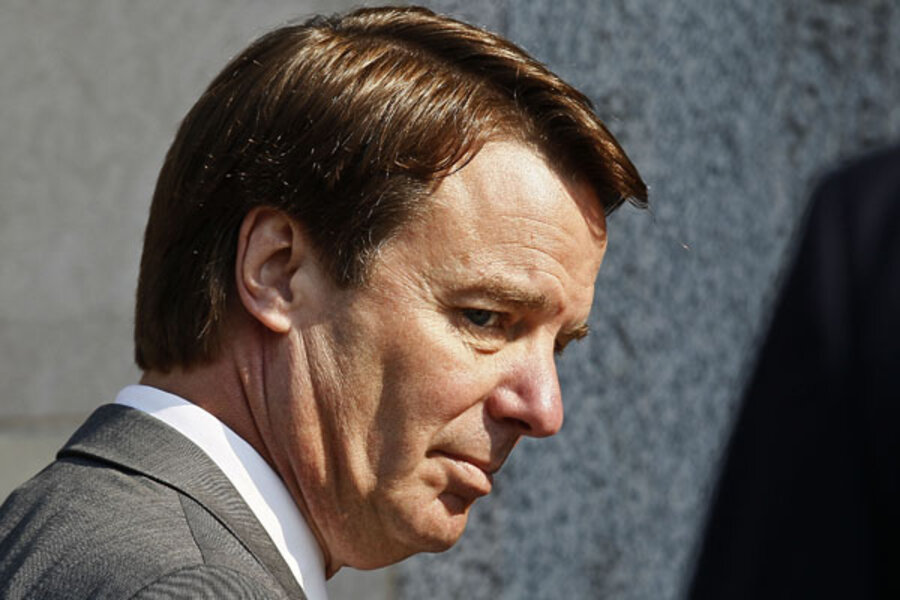Seven days in, still no verdict in Edwards trial
Loading...
Prosecutors and defense attorneys gathered in the federal courtroom on Tuesday afternoon where spectators were awaiting a verdict from the jury deliberating the fate of John Edwards.
It was shortly before 4:30 p.m. EDT, the typical quitting time for the day. Judge Catherine Eagles took her place at the bench, allowed everybody to get settled back in their seats after all rose for her. Then, while the jury was still out of the courtroom, she looked coyly at the faces staring up at her.
“The jury sent me a note saying they’ve reached,” Eagles said, letting a long dramatic pause linger in the air.
Then with a smile and a bit of a heave of her shoulders, she finished the sentence with “a good stopping point.”
The seventh day of deliberations ended without a verdict, and with many questions among media crews and the small group of spectators who have made a habit of spending their day inside the windowless wood-paneled courtroom in downtown Greensboro.
Could the jurors be hopelessly divided, but not yet ready to declare themselves at an impasse?
Were they still going through the six charges methodically, not yet settled on all counts?
Since Thursday, the jury has had all the evidence published at the trial inside its deliberation room.
The judge has not brought the eight men and four women out from behind closed doors to answer questions about evidence. There have been no public discussions about any questions regarding the law or judge’s instructions.
On Tuesday, after a long holiday weekend, prosecutors and defense lawyers met with the judge in a closed courtroom, keeping the public waiting and out of the loop about what was being discussed.
One of the alternate jurors, a woman whose trendy red top and smiles and giggling in the courtroom were the subject of many Twitter reports and blogs last week, was taken into the courtroom by one of the security guards on Tuesday and then quickly ushered back out during the closed session.
The courtroom was opened after that and dozens of media representatives sat on the wood pews, reading and waiting for any sign of a decision from the 12 behind closed doors.
The alternate jurors have now been at the courthouse for seven days with little to do. They sat through opening statements, almost four weeks of testimony and closing arguments, they found out they were the four who would be on call if one of the initial 12 jurors could not follow through with their service.
The alternates have been instructed not talk about the case among themselves or with others. They still cannot read or watch media accounts and they cannot talk with the jury about the case, though they all eat lunch together.
The alternate jurors, who smile across the courtroom at the 12 they used to sit among, caused a stir among spectators last week when they all wore yellow shirts on Thursday and red on Friday, either intentionally or coincidentally.
On Tuesday, they wore black and gray.
Before sending the alternates and 12 on the jury off to lunch on Tuesday, Eagles cautioned them more firmly than she has for many weeks.
“After juries have deliberated for a while, there are a number of things that can happen,” Eagles said. “Some of them are not good.”
She told them not to surf the Internet or look up anything about the case. She cautioned them not to engage in any deliberations outside the jury room and to make sure all on the jury were present. A verdict, she said, should be derived from a collective process.
“Small group discussions … have the potential to be divisive,” Eagles said.
Some of the jurors have alerted the judge to potential scheduling conflicts if the deliberations continue through this week and into the next.
“It appears to be high school graduation season,” Eagles said to grim faces among the lawyers and media crews hoping for the deliberations to close sooner than that.
Edwards, 58, is accused of six felonies related to violations of campaign finance law. The allegations are tied to more than $900,000 provided by two billionaire supporters to support his pregnant mistress during his 2008 presidential run.
Jury selection was completed on April 23 and opening statements followed that day.
The jury began its deliberations on May 18, a Friday, and quickly asked for many exhibits, a sign that they were not likely to reach a quick verdict.







